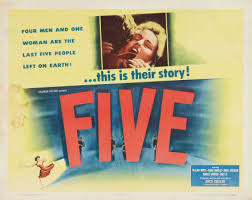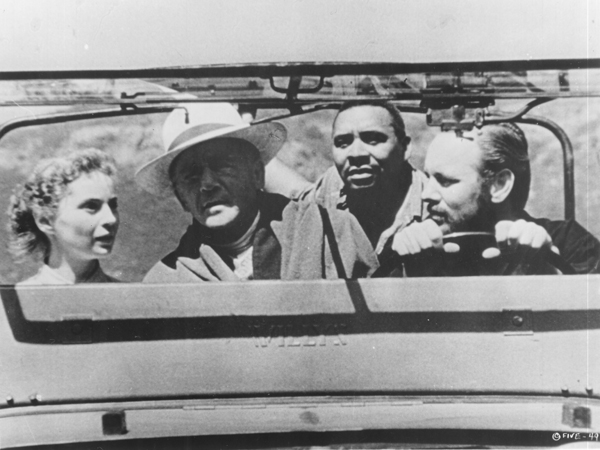“Five” (1951)
Sci-Fi/Horror

Running time: 91 minutes
Written and Directed by: Arch Oboler
Featuring: William Phipps, Susan Douglas Rubeš, James Anderson, Charles Lampkin and Earl Lee
Michael: “He’s dead, they’re all dead! We live in a dead world! And I’m glad it’s dead… cheap, honky-tonk of a world.”
Released recently on Blu-ray for the very first time anywhere is the classic horror/sci-fi film “Five” (1951) that was not only one of the very first movies that had as its setting life after a possible Atomic apocalypse but also tapped into very real fears of the time with this movie actively portraying an existential existence by the survivors who would all analyse their own new existences in conversation with little action and a narrative that was out of step with the expected Hollywood narrative that was almost universally portrayed in mainstream movies.
The science fiction drama Five (1951) was produced independently on a very low budget by Arch Oboler, famous in the 1940s for his radio productions, including the popular series Lights Out. Oboler produced, wrote, and directed Five, shot it largely on his own property, and hired a small, inexpensive crew made up of recent graduates from The University of Southern California film school. His cast was also small (as the title implies), and were made up of unknowns. The finished film was sold outright to Columbia Pictures for a tidy profit. It is remembered today as the first film to portray life after a nuclear holocaust.
The movie begins with Roseanne Rogers (Susan Douglas Rubeš) who trudges from place to place, searching for another living human being. A Mountain News headline reports a scientist’s warning that detonating a new type of atomic bomb could cause the extinction of humanity. Rosanne eventually makes her way to her aunt’s isolated hillside house and faints when she finds Michael (William Phipps) already living there. At first she is too numb to speak and slow to recover. She later resists Michael’s attempted sexual assault, revealing that she is married and also pregnant. Two more survivors arrive, attracted by the smoke coming from the house’s chimney. Oliver P. Barnstaple (Earl Lee) is an elderly bank clerk who is in denial about his situation; he believes he is simply on vacation. Since the atomic disaster, he has been taken care of by Charles (Charles Lampkin), a thoughtful and affable African American. They both survived because they were accidentally locked in a bank vault when the disaster happened. Roseanne was in a hospital’s lead-lined X-ray room, while Michael was in an elevator in New York City’s Empire State Building. Barnstaple sickens, but seems to recover and then insists on going to the beach. There, they drag a man named Eric (James Anderson) out of the ocean. He is a mountain climber who became stranded on Mount Everest by a blizzard during the atomic disaster. The survivors interact with each other in a small location all the while coming to grips with what has happened to them and their world with increasing difficulty although there is an ending that offers some hope.
Considering “Five” was produced in 1951 it is prescient in terms of movies that were to follow not only with all the Cold War era science fiction movies that were produced over the next ten to twenty years but also to the three post Nuclear war movies that were produced in the 1980s those being “Testament” (1983), “The Day After” (1983) and “Threads” (1984) that all focus on the events leading up to the war as well as war itself but their third acts all feel like “Five” albeit more shocking and ‘realistic’ for the time. In fact for what was publicly known about the aftermath of an Atomic war “Five” probably mirrors what many people may have thought, that buildings would be left standing while people would have been killed or vaporised. It was not until the footage of Hiroshima and Nagasaki were released as well as the aforementioned movies that the reality of what existence would look like in the aftermath. However where “Five” comes into its own is the idea of what life might be in an abstract way, that is the emotional turmoil that would follow which remains coherent and relevant today in terms of any great event or loss, this can be seen in events such as 9/11, major seismic events or even deeply personal losses.
“Five” written and directed by Arch Obler who was not only a contemporary of Orson Welles but who also had a career that was similar to Welles in that he started in radio and movies on top film on his own terms which is saying something for the time in which he lived. In fact in some ways Obler had a more fulfilling career than Welles who was never able to get past “Citizen Kane” (1939). Obler not only worked on radio and in film but was able to be involved on stage and on television all very successfully, he operated within the system but always on his own terms.
I highly recommend “Five” to all who enjoy some meaning behind their films as well as a glimpse into the past, if anything this film is all meaning and is a welcome juxtaposition to those movies that would come later in the decade, “Five” is a first amount its genre, it has a European feeling in that it is all about character and emotion with little regard for surroundings, I loved this movie.
Special Features
• NEW Audio Commentary by film historians Glenn Erickson & Matthew Rovner (2020)
• NEW Kim Newman Interview on “Five” (2020) 24:37
• Theatrical Trailer (2:02)




